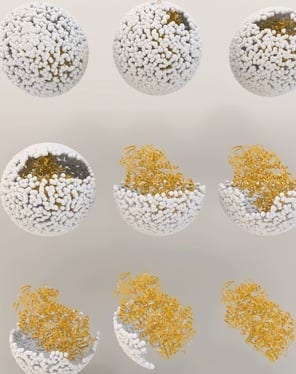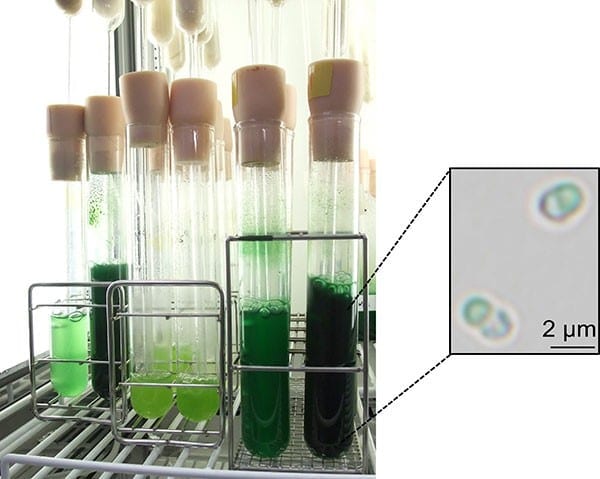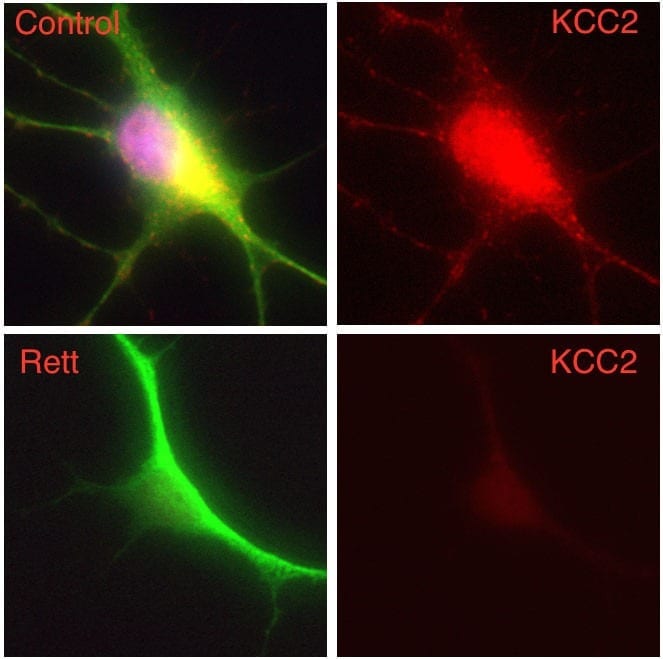
Combining bacterial genes and virus shell creates a highly efficient, renewable material used in generating power from water
Scientists at Indiana University have created a highly efficient biomaterial that catalyzes the formation of hydrogen — one half of the “holy grail” of splitting H2O to make hydrogen and oxygen for fueling cheap and efficient cars that run on water.
A modified enzyme that gains strength from being protected within the protein shell — or “capsid” — of a bacterial virus, this new material is 150 times more efficient than the unaltered form of the enzyme.
The process of creating the material was recently reported in “Self-assembling biomolecular catalysts for hydrogen production” in the journal Nature Chemistry.
“Essentially, we’ve taken a virus’s ability to self-assemble myriad genetic building blocks and incorporated a very fragile and sensitive enzyme with the remarkable property of taking in protons and spitting out hydrogen gas,” said Trevor Douglas, the Earl Blough Professor of Chemistry in the IU Bloomington College of Arts and Sciences’ Department of Chemistry, who led the study. “The end result is a virus-like particle that behaves the same as a highly sophisticated material that catalyzes the production of hydrogen.”
Other IU scientists who contributed to the research were Megan C. Thielges, an assistant professor of chemistry; Ethan J. Edwards, a Ph.D. student; and Paul C. Jordan, a postdoctoral researcher at Alios BioPharma, who was an IU Ph.D. student at the time of the study.
The genetic material used to create the enzyme, hydrogenase, is produced by two genes from the common bacteria Escherichia coli, inserted inside the protective capsid using methods previously developed by these IU scientists. The genes, hyaA and hyaB, are two genes in E. coli that encode key subunits of the hydrogenase enzyme. The capsid comes from the bacterial virus known as bacteriophage P22.
The resulting biomaterial, called “P22-Hyd,” is not only more efficient than the unaltered enzyme but also is produced through a simple fermentation process at room temperature.
The material is potentially far less expensive and more environmentally friendly to produce than other materials currently used to create fuel cells. The costly and rare metal platinum, for example, is commonly used to catalyze hydrogen as fuel in products such as high-end concept cars.
“This material is comparable to platinum, except it’s truly renewable,” Douglas said. “You don’t need to mine it; you can create it at room temperature on a massive scale using fermentation technology; it’s biodegradable. It’s a very green process to make a very high-end sustainable material.”
In addition, P22-Hyd both breaks the chemical bonds of water to create hydrogen and also works in reverse to recombine hydrogen and oxygen to generate power. “The reaction runs both ways — it can be used either as a hydrogen production catalyst or as a fuel cell catalyst,” Douglas said.
The form of hydrogenase is one of three occurring in nature: di-iron (FeFe)-, iron-only (Fe-only)- and nitrogen-iron (NiFe)-hydrogenase. The third form was selected for the new material due to its ability to easily integrate into biomaterials and tolerate exposure to oxygen.
NiFe-hydrogenase also gains significantly greater resistance upon encapsulation to breakdown from chemicals in the environment, and it retains the ability to catalyze at room temperature. Unaltered NiFe-hydrogenase, by contrast, is highly susceptible to destruction from chemicals in the environment and breaks down at temperatures above room temperature — both of which make the unprotected enzyme a poor choice for use in manufacturing and commercial products such as cars.
These sensitivities are “some of the key reasons enzymes haven’t previously lived up to their promise in technology,” Douglas said. Another is their difficulty to produce.
“No one’s ever had a way to create a large enough amount of this hydrogenase despite its incredible potential for biofuel production. But now we’ve got a method to stabilize and produce high quantities of the material — and enormous increases in efficiency,” he said.
Read more: IU scientists create ‘nano-reactor’ for the production of hydrogen biofuel
The Latest on: Hydrogen biofuel
[google_news title=”” keyword=”hydrogen biofuel” num_posts=”10″ blurb_length=”0″ show_thumb=”left”]
via Google News
The Latest on: Hydrogen biofuel
- MIT Technology Reviewon May 1, 2024 at 3:02 pm
Ethanol makers who use sustainably produced corn can now qualify for big federal tax credits, but critics are skeptical of the carbon benefits.
- EPA approves renewable gasoline blendstock derived from researchers' inventionon May 1, 2024 at 12:04 pm
Science X is a network of high quality websites with most complete and comprehensive daily coverage of the full sweep of science, technology, and medicine news ...
- Hydrogen- and Biofuel-Powered Ferries to Be Delivered in 2026on April 30, 2024 at 11:58 pm
The ships will take 85% of their power needs from hydrogen fuel cells and 15% from biofuel, and are scheduled for delivery in 2026.
- Dusty 'Cat's Paw Nebula' contains a type of molecule never seen in space — and it's one of the largest ever foundon April 30, 2024 at 10:00 am
Scientists have detected a new, unusually large molecule never seen in space before. The 13-atom molecule, called 2-methoxyethanol, was detected in the Cat's Paw Nebula.
- The trucking life of the internal combustion engine going forwardon April 30, 2024 at 5:00 am
The zero-emissions trucking future will be a mix of powertrain technologies including battery electric, hydrogen fuel cell and, yes, even internal combustion engines. The transition to electric ...
- TotalEnergies chief Pouyanne slams EU hydrogen targets as ‘impossible’on April 30, 2024 at 2:29 am
Prices will not come down if renewable hydrogen is used in hard-to-abate industries only, warns Patrick Pouyanne ...
- Legislators too ‘trigger-happy' on banning alternative fuels, Volvo Trucks sayson April 29, 2024 at 11:43 am
As legislators and regulators across the globe pursue fully emissions-free transportation, Volvo Truck's complaint raises questions about whether alternative fuels have a role to play in a green ...
- Beaulieu: Hydrogen is not the answeron April 28, 2024 at 2:01 am
Solar power and battery storage are clean energy solutions but “clean hydrogen” and “green biofuels” are misnomers used by Granite Shore Power.
- New $60m lab in S’pore to drive R&D in carbon capture, biofuels and hydrogenon April 26, 2024 at 8:20 pm
Transforming Singapore’s energy and chemical sectors will be a priority, says DPM Heng Swee Keat. Read more at straitstimes.com.
- Aviation giants focus on hydrogen in flight to net zeroon April 23, 2024 at 5:08 am
Liquid hydrogen, on the other hand, doesn’t require large, heavy tanks, but it does require being cooled to -253°C, which is cryogenic. That has significant challenges. It also takes up four times the ...
via Bing News










